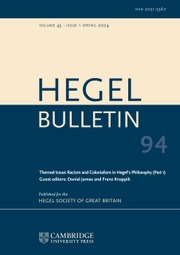Article contents
Normativity and the Acquisition of the Categories
Published online by Cambridge University Press: 22 April 2013
Abstract
It is quite common when explicating the nature of Kant's break with the preceding Early Modern tradition to cite his attitude towards the acquisition and deployment of concepts. It is claimed that Kant sought to distinguish two tasks that had become unfortunately intertwined and conflated — explaining how we come to acquire our concepts on the one hand and showing how we are justified in deploying them in judgement on the other. This conflation can be expressed in terms of a conflation of the natural and the normative, of descriptive and prescriptive questions. The topic of the conditions of concept-possession, i.e. how we have come to possess the concepts that we do, is an entirely psychological inquiry, involving ‘natural’ descriptive inquiries. The topic of concept-deployment, the story about how we use our concepts in veridical judgements about the world, is an entirely philosophical question, since it involves the question of how we ought to deploy those concepts in judgement. The fundamental distinction between the natural and the normative is drawn by Kant, it is claimed, in order to distinguish these two practices of acquisition and deployment.
The manner in which this claim is expressed is through Kant's distinction between the question of fact (quaestio facti) and the question of right (quaestio juris). I want to claim that a proper understanding of this distinction doesn't support this notion of Kant's ‘normative turn’. In fact, the distinction is best understood within an interpretation whereby Kant is understood as continuing to endorse the Early Modern conviction that the provision of a concept's possession-conditions is sufficient to determine that concept's deployment-conditions, and that the task of the Transcendental Deduction is to determine the possession-conditions for the Categories.
- Type
- Research Article
- Information
- Copyright
- Copyright © The Hegel Society of Great Britain 2011
References
- 3
- Cited by


